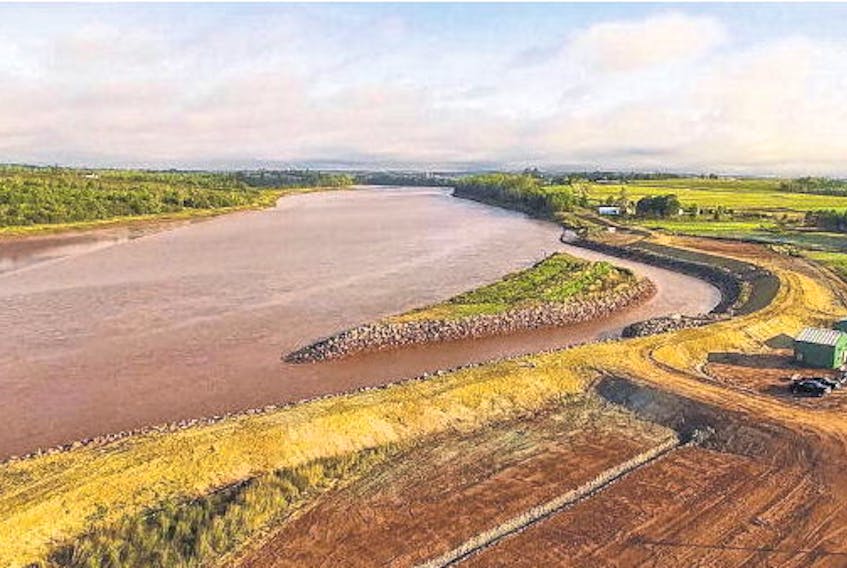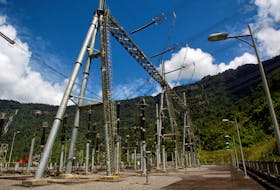The company that intends to gradually discharge 1.3 million cubic metres of salt into the Shubenacadie River estuary says it searched unsuccessfully for disposal alternatives.
“The Alton environmental assessment in 2007 looked at commercial and technical alternatives to brine release, but they were not considered economic or feasible,” said Lori MacLean, spokeswoman for Alton Natural Gas Storage LP.
“Recently, commercial and technical alternatives to brine release into the tidal estuary were revisited by the Alton team, including underground storage, salt market and evaporation, but again were not found to be commercially or technically feasible.”
The company, a subsidiary of AltaGas, plans to draw nearly 10,000 cubic metres of water daily from the Shubenacadie River estuary at Fort Ellis and propel it through a 12-kilometre underground pipeline to the Brentwood Road cavern site. There, the water will be pumped nearly 1,000 metres underground to flush out salt, creating two caverns, each about the size of an average office building and capable of storing up to six billion cubic feet of natural gas.
The brine created by the salt dissolution will then be pumped back to the estuary for release into the river system, a gradual discharge of 1.3 million cubic metres of salt over a two- to three-year period.
There have been recent suggestions that the salt brine could be used by the province to de-ice some of its highways.
Transportation Minister Lloyd Hines was not available for an interview this week but spokeswoman Marla MacInnis said in an email that the department is not involved in any discussions with Alton Gas.
She said the 240,000 tonnes of salt used annually on Nova Scotia highways comes from Pugwash, Magdalen Islands and the Bahamas. The average cost of buying the salt, including trucking to locations, is $81 per tonne. The cost to apply the salt is separate. The salt is hauled to the province’s 53 storage locations and is spread in both brine and rock form.
The Canadian Salt Company runs the mine in Pugwash that produces a good portion of the highway salt. The 2007 environmental assessment application from Alton Gas explained that the sale of brine to the Canadian Salt Company or to Sifto Canada and the “supply of brine to provincial and municipal users for winter maintenance of roads and producing evaporated salt for commercial sale were investigated.”
The application said that the total consumption of brine in the province for pre-wetting highways during the winter season was expected to reach a maximum of 2,800 cubic metres a year.
“The potential market for Alton brine as a pre-wetting supply is very small and represents less than one day of Alton production per year,” according to the environment application.
It concluded that the evaporation facilities at Canadian Salt and Sifto consume saturated brine at an average combined rate of 1,560 cubic metres per day.
“Cost of brine generation is low while brine quality and supply are well established and secure,” the application said. “Freight cost for delivering brine from Alton to producers is estimated at 13 times the cost of brine produced on site.”
A scenario of building an evaporator plant withdownstream equipment and storage for the Alton project was also considered.
“On a capital and operating cost basis alone, such a facility cannot compete with the established producers,” the environmental registration report said. “In addition, the current markets are over-supplied and volumes such as those contemplated from Alton are excessive when compared even to national volumes for evaporated salt.”
MacLean said Alton’s brine release will take place in the Shubenacadie’s “powerful tidal estuary that fills with salt water from the ocean twice a day.”
She said that brining operations at Alton must stop when the river’s natural salinity reaches 28 parts per thousand, which is within the range of salinity for the river. As designed, salinity at the Alton discharge location must mirror the conditions in the river, MacLean said.
“If a technical or economic alternative to brine release is identified, Alton would be open to exploring that,” MacLean said.
The company announced recently that the anticipated start date for storing gas in the caverns has been moved up to sometime in 2021. Prior to that undetermined date, the brining process will take two to three years.
The project is strongly opposed by area residents, environmentalists and the nearby Indian Brook First Nation.








